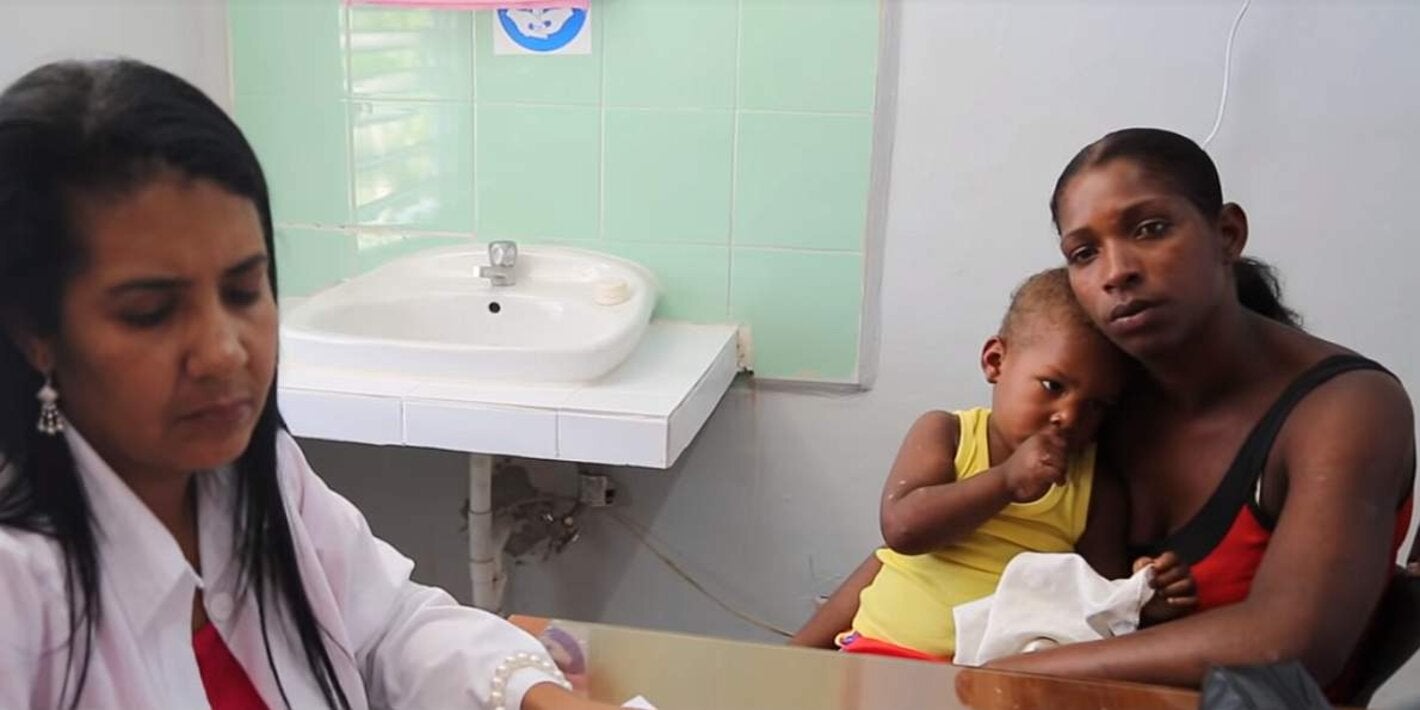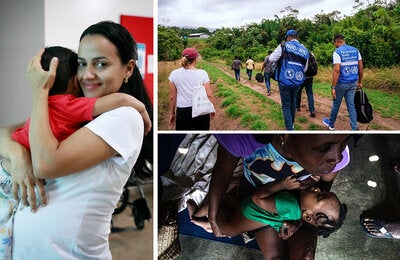
Washington DC-Geneva- Cuba today became the first country in the world to receive validation from the World Health Organization (WHO) that it has eliminated mother-to-child transmission of HIV and syphilis.
"Eliminating transmission of a virus is one of the greatest public health achievements possible," said Dr Margaret Chan, WHO Director-General. "This is a major victory in our long fight against HIV and sexually transmitted infections, and an important step towards having an AIDS-free generation."
"Cuba's success demonstrates that universal access and universal health coverage are feasible and indeed are the key to success, even against challenges as daunting as HIV," Dr Carissa F. Etienne, Director of the Pan American Health Organization (PAHO), WHO's Regional Office for the Americas, said today during a press event at PAHO headquarters, where the achievement was announced.
"This is a celebration for Cuba and a celebration for children and families everywhere. It shows that ending the AIDS epidemic is possible, and we expect Cuba to be the first of many countries coming forward to seek validation that they have ended their epidemics among children," said Michel Sidibé, Executive Director of UNAIDS.
The challenge
Every year, globally, an estimated 1.4 million women living with HIV become pregnant. Untreated, they have a 15-45% chance of transmitting the virus to their children during pregnancy, labor, delivery or breastfeeding. However, that risk drops to just over 1% if antiretroviral medicines are given to both mothers and children throughout the stages when infection can occur. The number of children born annually with HIV has almost halved since 2009 — down from 400,000 to 240,000 in 2013. But stepped-up efforts will be needed to reach the global target of less than 40,000 new child infections per year by 2015.
Nearly 1 million pregnant women worldwide are infected with syphilis annually. This can result in early fetal loss and stillbirth, neonatal death, low-birth-weight infants and serious neonatal infections. However, simple, cost-effective screening and treatment options during pregnancy, such as penicillin, can eliminate most of these complications.
Cuba's achievement
PAHO/WHO has been working with partners in Cuba and other countries in the Americas since 2010 to implement a regional initiative to eliminate mother-to-child transmission of HIV and syphilis.
Mother-to-child transmission of these diseases is considered eliminated when the rates of infection are brought to levels so low as to be considered no longer a public health problem. In the case of HIV, this is defined as fewer than 2 in every 100 babies born to women with HIV, which is the lowest rate considered possible with the prevention methods currently available. In the case of syphilis, elimination is defined as less than 1 case for every 2,000 live births.
As part of the regional initiative, Cuba has worked to ensure early access to prenatal care, HIV and syphilis testing for both pregnant women and their partners, treatment for women who test positive and their babies, substitution of breastfeeding, and prevention of HIV and syphilis before and during pregnancy through condom use and other prevention measures. These services are provided as part of an equitable, accessible and universal health system in which maternal and child health programs are integrated with programs for HIV and sexually transmitted infections.
As a result of these efforts, in 2013, only two babies were born with HIV in Cuba, and only three were born with congenital syphilis — reflecting transmission rates below the elimination thresholds.
"This validation constitutes high recognition for the Cuban national health system as well as a stimulus and commitment to continue perfecting our work for the well-being of mothers, children and all our people," said Minister of Health of Cuba Roberto Morales Ojeda.
Progress in Latin America and the Caribbean
In Latin America and the Caribbean as a whole, 45% fewer babies were born with HIV in 2013 than in 2010, when 2,324 babies were born with the virus. During the same period, the proportion of pregnant women tested for HIV rose to 74% (a 19% increase over 2010), and the proportion of pregnant women with HIV who were receiving antiretroviral treatment rose to 93% (up 34 percentage points).
During the same period, coverage rates for syphilis testing remained stable in Latin America and the Caribbean, at around 80%, while the proportion of women receiving treatment for syphilis ranged between 13% and 100% in countries reporting data.
Besides Cuba, six other countries and territories of the Americas are in a position to request validation for their elimination of mother-to-child transmission of both HIV and syphilis: Anguilla, Barbados, Canada, Montserrat, Puerto Rico and the United States. Eight others are believed to have reached the target for HIV, and 14 are believed to have achieved the target for congenital syphilis.
Global efforts to stop mother-to-child transmission of HIV and syphilis
There have been major efforts worldwide in recent years to ensure that women get the treatment they need to keep themselves well and their children free from HIV and syphilis. A number of countries in other regions are also poised to eliminate mother-to-child transmission of both diseases.
In 2007, WHO launched the Global elimination of congenital syphilis: rationale and strategy for action. The strategy aims to increase global access to syphilis testing and treatment for pregnant women. By 2014, more than 40 countries were testing 95% or more of pregnant women in prenatal care for syphilis. But although progress has been made, many countries have still to prioritize preventing and treating mother-to-child transmission of syphilis. In 2012, syphilis affected 360 000 pregnancies through stillbirths, neonatal deaths, prematurity, and infected babies.
Then, in 2011, UNAIDS with WHO and other partners launched a global plan to eliminate new HIV infections among children by 2015 and to keep their mothers alive.
Between 2009 and 2013, there was a 100% increase in the proportion of pregnant women living with HIV in low- and middle-income countries receiving effective antiretroviral medicines to prevent transmission of the virus to their children. In these countries, seven out of 10 pregnant women living with HIV currently receive effective antiretroviral medicines to prevent transmission of the virus to their children.
WHO validation process
In 2014, WHO and key partners published global guidance outlining the validation process and the different indicators countries need to meet.
An international expert mission convened by PAHO/WHO visited Cuba in March 2015 to validate progress toward the elimination of mother-to-child transmission of HIV and syphilis. During a five-day visit, members visited health centers, laboratories, and government offices throughout the island, interviewing health officials and other key actors. The mission included experts from Argentina, the Bahamas, Brazil, Colombia, Italy, Japan, Nicaragua, Suriname, the United States of America and Zambia.
The validation process paid particular attention to the upholding of human rights, in order to ensure that services were provided free of coercion and in accordance with human rights principles.
Note to editors:
Required validation indicators include:
HIV Impact Indicators — must be met for at least 1 year
- New pediatric HIV infections due to mother-to-child transmission (MTCT) of HIV are less than 50 cases per 100,000 live births; and
- MTCT rate of HIV is less than 5% in breastfeeding populations or less than 2% in non-breastfeeding populations
Process Indicators — must be met for at least 2 years
- More than 95% of pregnant women, both who know and do not know their HIV status, received at least one antenatal visit
- More than 95% of pregnant women know their HIV status
- More than 95% of HIV-positive pregnant women receive antiretroviral drugs
Syphilis Impact Indicators — must be met for at least 1 year
- Rate of MTCT syphilis is less than 50 cases per 100 000 live births
Process Indicators — must be met for at least 2 years
- More than 95% of pregnant women received at least one antenatal visit
- More than 95% of pregnant women are tested for syphilis
- More than 95% of pregnant women with syphilis receive treatment.
The term "validation" is used to attest that a country has successfully met criteria (internationally set targets for validation) for eliminating MTCT of HIV and/or syphilis at a specific point in time, but countries are required to maintain ongoing programs
Quick facts on mother-to-child transmission of HIV and syphilis in the Americas
- 2,324 babies were born with HIV in Latin America and the Caribbean in 2013, down 78% from 10,700 in 2001. This represents around 5% of all babies born in the region to mothers with HIV
- Cases declined more in the Caribbean (72%) during the period than in Latin America (22%)
- 52,000 children and adolescents aged 14 and under in Latin America and the Caribbean are living with HIV
- 74% of pregnant women in Latin America and the Caribbean were tested and received counseling for HIV in 2013
- 93% of HIV-positive mothers-to-be received antiretroviral treatment, a significant increase over the 59% who received treatment in 2010
- Between 2008 and 2012, cases of congenital syphilis declined nearly 50% in the Americas, from 29,061 to 14,779
- 81% of pregnant women were tested for syphilis in 2013
- Very few countries report data on the number of pregnant women who have syphilis and are receiving treatment. Among the countries that do, the proportion varies from 13% to 100%.
- There were between 20,000 and 45,000 pregnant women with HIV in 2013 in the region
- Including Cuba, 9 countries and territories of the Americas have achieved the target for eliminating mother-to-child transmission of HIV, while15 (including Cuba) have achieved the target for eliminating congenital syphilis.
- 7 countries and territories of the Americas, including Cuba, have eliminated vertical transmission of both diseases: Anguilla, Barbados, Canada, Montserrat, Puerto Rico and the United States. Cuba is the only one that has received validation.



